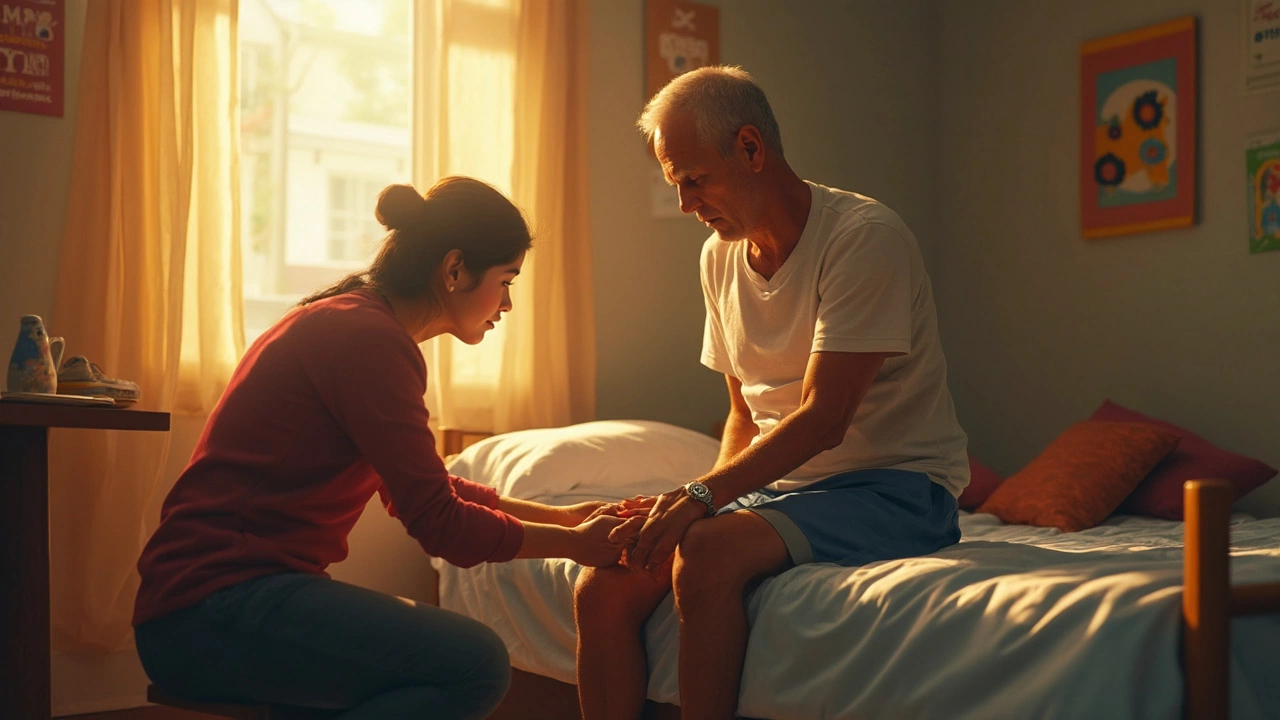Knee replacement is supposed to give you better movement, but what’s with the stiffness that just won’t quit? Lots of people worry about this—especially when tightness sticks around longer than expected. Truth is, almost everyone feels some stiffness right after surgery. You just went through a major remodeling job inside your knee.
But how long does that stiffness last? Does it ever fully go away? And what can you actually do when simple things like getting up from a chair or climbing stairs still feel awkward months later? Most folks get some relief over time, but there are times when stiffness likes to hang on.
If you’re dealing with a stubborn knee that doesn’t bend or straighten the way it should, you’re not alone. The good news: there are practical ways to help your knee loosen up and tips to spot possible trouble. Let’s break down what’s normal, what’s not, and how to speed up your recovery so life gets moving again.
- Why Stiffness Happens After Knee Replacement
- How Long Does Stiffness Last?
- What Actually Helps Stiffness Go Away
- When to Be Concerned and What to Do Next
Why Stiffness Happens After Knee Replacement
Stiffness after a knee replacement is super common, especially in the first few weeks. Your body just went through a big operation—muscles, ligaments, and soft tissues were moved around, and even some bone was reshaped. That’s enough to make any joint feel tight.
One reason you feel stiff is swelling inside the knee. Swelling makes it tough for the new joint to glide smoothly, almost like trying to move a rusty hinge. That’s why icing and keeping your leg raised is often suggested right after surgery.
Scarring is another usual suspect. As your knee heals, scar tissue (what doctors call "arthrofibrosis") can build up around the joint. Too much scar tissue shrinks your range of motion and creates a stiff, stubborn knee. This is why doctors are so big on stretching and moving the knee early—even while it still hurts a little.
Sometimes, your own habits can play a role. Laying in bed or avoiding bending the knee out of fear can actually make the stiffness worse. Muscles need action or they start to tighten up and weaken, causing even more trouble down the road.
There are some risk factors that make stiffness more likely:
- Having a stiff knee before surgery
- Being older or overweight
- Ignoring physical therapy instructions
- Medical conditions like diabetes (it hampers healing)
- Problems during surgery, like too much bleeding or infection
A 2023 survey from a large orthopedic clinic found that about 20% of knee replacement patients still have some stiffness three months after surgery. But the folks who stayed active and didn’t skip physical therapy appointments had much less trouble with lingering tightness.
So, the bottom line? Swelling, scar tissue, and not moving enough are the usual culprits, and some simple habits can make a big difference in how flexible your new knee feels.
How Long Does Stiffness Last?
This is the question everyone wants answered after a knee replacement. For most people, the worst knee stiffness gets better within the first 3 months. You’ll notice real improvement just a few weeks after the operation—especially if you’re sticking with your physical therapy. But, don’t panic if you don’t get your full range of motion right away.
Doctors say it can take 6–12 months for your knee to reach its best bend and stretch. For some, swelling and stiffness can stick around a little longer. Pro tip: the more you move (within reason), the faster you usually gain flexibility. If you avoid exercises out of fear or pain, your joint might tighten up even more.
Here’s a breakdown of what people usually experience:
- First 6 weeks: Stiffness is most pronounced; it’s hard to bend or straighten fully.
- 7–12 weeks: Range of motion gradually improves as soreness goes down.
- 3–6 months: Most people notice daily tasks (like stairs or getting up from a chair) feel easier.
- 6–12 months: Final improvements happen here, but your knee still might not feel totally "normal" yet.
Want some numbers? A study tracking knee replacement patients found that about 85% reach good flexibility (meaning they can bend their knee at least 110 degrees) by 12 months. Still, about 5–10% have ongoing trouble with stiffness that never quite goes away without extra help from their medical team.
If your knee seems frozen long after everyone else has bounced back, it doesn’t mean you failed. Sometimes, scar tissue is just stubborn. There are options—like extra therapy or, in rare cases, a procedure to break up extra scar tissue. The important thing is to keep moving and don’t get discouraged if healing doesn’t follow a perfect textbook timeline.

What Actually Helps Stiffness Go Away
Tackling stiffness after a knee replacement isn’t just about waiting it out. Getting your movement back means putting in the work and knowing what helps the most. Good news: you’re not stuck with that tight feeling if you follow tips that orthopedic teams swear by.
The basics start with physical therapy. It's the number one tool for helping your knee move the way it should. Daily exercises focus on stretching and strengthening muscles, without pushing too far too fast. Even small movements, done regularly, keep scar tissue from building up and locking the joint.
Here’s what shows real results:
- Stick with your exercises – Your therapist will give you a routine. Doing those exercises 2–3 times a day can make all the difference, especially in the first two months after surgery.
- Don’t skip your appointments – In-person physical therapy is proven to help reduce stiffness and improve your range of motion.
- Bend and straighten often – Even during TV time, try flexing your knee gently—straightening it all the way, then bending it as much as you can tolerate.
- Use ice and elevation – Swelling makes stiffness worse. Applying ice packs for 15–20 minutes and keeping your leg propped up helps manage swelling.
- Stay on top of pain – If pain makes you hold back on movement, talk to your doctor. Taking prescribed medicines before exercise can help you push further without overdoing it.
A respected surgeon at Mayo Clinic, Dr. Daniel Berry, sums it up well:
"Stiffness after knee replacement usually gets better with the right exercises and a little patience. The more consistent you are with movement, the more likely your knee will loosen up over time."
If you're the numbers type, here's what studies show can make a difference:
| Tip | Improvement in Range of Motion (average) |
|---|---|
| Physical therapy (3x/week) | +25 degrees |
| Daily home exercises | +18 degrees |
| Consistent pain management | +15 degrees |
Sometimes, knee stiffness just won’t budge even after months of hard work. If that’s the case, doctors might recommend specialized treatments like scar tissue release (called a "manipulation under anesthesia"). But for most folks, sticking to the basics—exercise, therapy, and good routines—really pays off.
When to Be Concerned and What to Do Next
So, when does that post-surgery knee stiffness cross the line from "normal healing" into "okay, something's not right"? Most doctors expect a knee to keep loosening up for the first 3 to 6 months after a knee replacement. If you’re still struggling to get your knee past 90 degrees or it just won’t straighten out several months later, it's time to pay attention.
Red flags include pain that keeps getting worse, swelling that won’t go down, or your knee suddenly giving out. If you ever see redness, fever, or the skin feels hot, get checked for infection—don’t wait and see. It’s rare, but infection or scar tissue can mess with your recovery and mobility.
Here's a simple checklist of when to call your surgeon after knee replacement:
- You can’t bend your knee more than 90 degrees after 3 months.
- Your knee won’t fully straighten by 10-12 weeks out.
- Pain or swelling actually gets worse instead of better.
- Your knee feels warm, red, or you have a fever.
- You can’t walk or do basic things like getting in or out of a car.
Don’t try to tough it out. Most issues have better outcomes if caught early. Your doctor might order an X-ray or check for infection, and sometimes stubborn stiffness calls for more aggressive treatments—like extra physical therapy, injections, or, in rare cases, a quick procedure to loosen up scar tissue (doctors call it a manipulation under anesthesia).
Here’s a peek at how doctors usually step things up for ongoing knee stiffness:
| Stage | Common Interventions |
|---|---|
| 3-12 weeks | Standard physical therapy, home exercises |
| 3-6 months | More intensive therapy, possible bracing, check for infection |
| 6 months+ | Manipulation under anesthesia, surgical review if needed |
Talk honestly with your healthcare team. If your mobility isn’t improving or you’re just not sure, ask. It’s always better to double-check than let avoidable problems take root.





